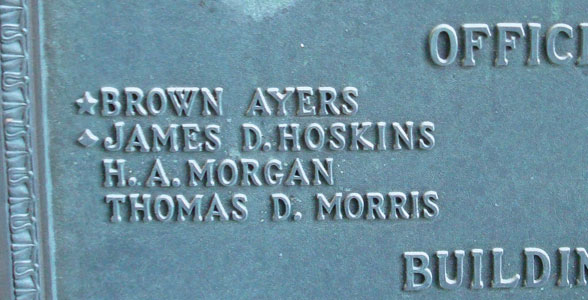By Elizabeth A. Davis and Betsey Creekmore
It’s easy to mistake the spelling of Ayres Hall. In fact, a plaque installed on the building itself in 1921 proclaimed Ayers instead of Ayres.
Ayres Hall is named for Dr. Brown Ayres, UT president from 1904 until his death in 1919. During his tenure, Ayres was credited with vastly improving the quality of the university.
The misspelled plaque gave rise to the myth that Ayres was not the candidate the UT trustees meant to name as president, but that is simply not correct.
The Board of Trustees began a search for a new president in 1903 after then-president Charles Dabney announced he was leaving UT to become president of the University of Cincinnati. In an interesting twist, at Cincinnati Dabney succeeded Howard Ayers, who was then nominated for the UT presidency. UT trustee Edward Terry Sanford acknowledged the nomination on April 2, 1904, as that of “Ayres [sic] of Cincinnati,” giving impetus to the confused legend.
But Alphonso C. Smith of the University of North Carolina, not Howard Ayers, was elected UT president. Smith visited UT on July 13, however, and declined the presidency.
The search committee then recommended a member of the faculty be elected to a 1-year term as acting president. At the Board of Trustees meeting on July 20, 1904, that recommendation was supplanted by the nomination of Brown Ayres by a Board of Trustees member. Historians believe Sanford had a letter from former president Dabney proposing and endorsing Brown Ayres, who was then dean of the faculty at Tulane University.
The trustees voted to accept Brown Ayres of Tulane on July 20, but due to the small number of trustees present, postponed the election until August 2, when Ayres was present to be chosen by unanimous vote.
Brown Ayres was born in Memphis and earned a doctorate in physics from the Stevens Institute of Technology in New Jersey. Because of his interest in electricity, he met Thomas Edison and Alexander Graham Bell and was offered a job with Bell’s company. Ayres declined Bell’s offer because he wanted to pursue teaching. He secured a professorship at Tulane University, where he rose through the administrative ranks to become acting president. He had just declined the presidency of the University of Alabama when UT’s job offer arrived.
Ayres died suddenly in 1919, 2 years after the university fought for and received $1 million in appropriations from the state to construct three buildings, including those that became Ayres Hall on the Hill and Morgan Hall on the agriculture campus.
Ayres’ successor as president of the university, Harcourt Morgan, recommended naming the new academic building on the Hill for Ayres, since Ayres had envisioned a central academic building and had worked closely with the architects to design it.
The misspelling of Ayres’ name on the building plaque remains a mystery. The Ayres Hall and Morgan Hall plaques were to be the same. The plaque at Morgan Hall correctly spells Ayres’ name. The Ayres plaque, however, misspells the name.
The mystery of the misspelling of Ayres rests with the Chicago Ornamental Iron Works, the firm that cast the plaques. Architects Miller, Fullenwider & Dowling ordered the two plaques at the same time, with the lists of names to be identical. The raised likeness of Ayres was unacceptable, and Knoxville artist Lloyd Branson provided information transmitted by Morgan about how the likeness should be modified. Several exchanges of correspondence ensued, and Miller, Fullenwider & Dowling finally approved the plaques for the two buildings. On October 18, 1921, Morgan wrote to Miller, Fullenwider & Dowling, “The blueprints for the bronze tablets were received yesterday. The names are spelled correctly.”
When the plaques arrived, they were installed, and for whatever reason, the incorrect Ayres plaque was not replaced in 1921 and remains today as an interesting quirk in UT history.
More than 50 years later, the Ayres family had a new plaque installed that appropriately commemorates UT’s 12th president. It even spelled his name correctly.



